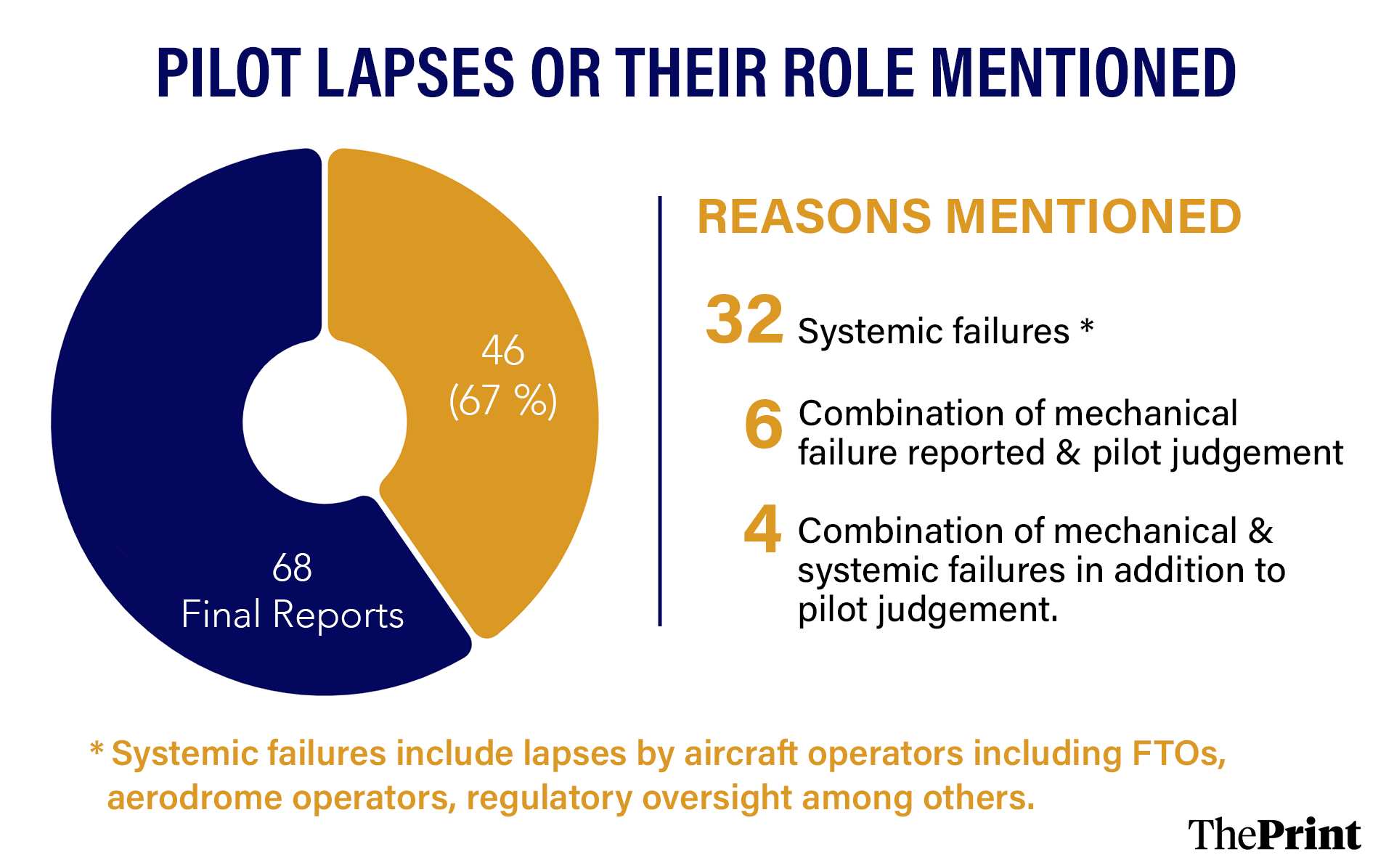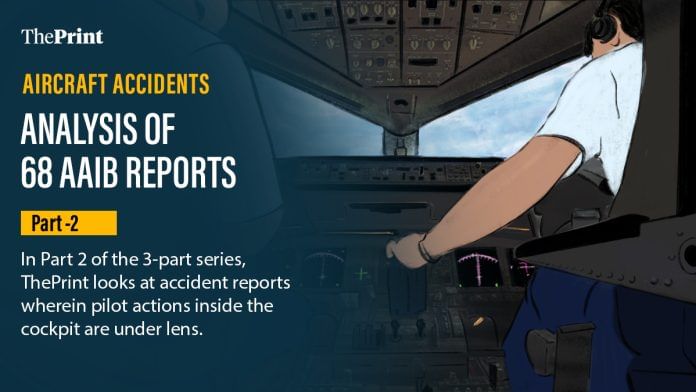This is part 2 of ThePrint’s three-part series. Read Part 1 here.
New Delhi: Pilot actions find mention in at least 67 percent of the 68 final reports the Aircraft Accident Investigation Bureau (AAIB) has put out on aircraft accidents since 2012, an analysis by ThePrint has shown.
These references are mentioned either in the findings under conclusions or under probable causes in both fatal and non-fatal accidents involving fixed winged aircraft.
Notably, the reports highlighting inflight erroneous actions, judgements of pilots or lapses don’t necessarily attribute all of these accidents to just errors by persons inside the cockpit.
The topic of pilot error recently took centrestage soon after the AAIB came out with its interim probe report on the tragic 12 June Air India plane crash in Ahmedabad that claimed the lives of all those on board barring one.
According to the report, soon after the aircraft took off, the fuel switches to both engines turned off one after the other, just one second apart. As the engines stopped getting fuel, their speeds began dropping from take-off levels. According to the cockpit audio, one pilot asked the other why he turned the fuel off, and the other pilot replied that he didn’t do it.
While global headlines pinned the crash on one of the pilots, the AAIB slammed these reports. In its interim report, it did not point to any error or deliberate action by the pilots as the reason for the 12 June crash.
In Part 2 of a three-part series on AAIB’s final reports on aircraft accidents, ThePrint looks at some of the cases where fingers have been raised at pilots for lapses.
The AAIB, India’s primary agency for investigating aviation accidents and incidents, was established on 30 July 2012 in compliance with ICAO (International Civil Aviation Organisation) Annex 13 guidelines. It functions under the Ministry of Civil Aviation, but works independently from the aviation watchdog Directorate General of Civil Aviation (DGCA).
According to the ‘Aircraft (Investigation of Accidents and Incidents) Rules’, the DG AAIB has to institute an investigation into the circumstances of accidents, and shall be responsible for conducting the probe.
‘Last line of defence’
Lack of coordination in the cockpit and disagreements between pilots, poor decision-making, lapses in judgement, failure to adhere to SOPs among others are mentioned as factors contributing to human error and complacency in as many as 46 final reports.
Moreover, the Bureau highlights issues such as lack of assertiveness among co-pilots, refusal of one pilot to hand over controls to the other, inadequate experience of the pilot-in-command (PIC), inappropriate handling, procedural violations, flying into severe weather despite awareness of its deterioration, and failure to monitor fuel levels and conduct proper pre-flight inspection leading to engine starvation.
“We aren’t denying or refuting that there are pilot errors. However it is important to understand that pilots are the last line of defense,” Captain Anil Rao, general secretary, Air Line Pilots Association, told ThePrint.
“The bigger question should be how did we reach that last line? It is a multitude of factors—mechanical, environmental, and even manufacturers’ defects. A pilot isn’t a robot. If they missed 1 out of the 100 things in the book, they are grounded and blamed. Sometimes pilots have less than a minute or just a couple of seconds to take a call.”
“One has to also understand that aircraft accidents involve multiple stakeholders and only when multiple errors align that it leads to a disaster,” Rao added.
‘Faulty HR policy’
The AAIB maintains that the sole objective of investigation is only the prevention of such accidents or incidents.
In the 2020 Air India Express crash in which 21 people, including both pilots, were killed in Kozhikode, the report attributes the probable cause to the pilot not adhering to SOPs, with contributing systemic failures including faulty HR policy that added pressure on the person sitting in the cockpit, among others.
Apart from “overconfidence”, the AAIB repeatedly cited poor decision-making by the PIC and noted his use of unprescribed drugs, which could have caused cognitive deficits.
The final report also points towards lack of coordination between the pilots.
“The first officer (FO) had correctly identified that the approach for runway 10 was an ‘unstabilised approach’. After making two unassertive attempts to attract the PIC’s attention towards the unstabilised approach, using non-standard vocabulary, he asked the PIC to ‘Go Around’ just before touchdown,” it mentions.
“In spite of knowing full well that the approach was unstabilised and the PIC was not responding, the FO did not take over the controls as per the company SOP and initiate a ‘Go Around’.”
In another 2014 accident of a Deccan charter operating from Delhi to Guwahati, the more qualified pilot was found to be the co-pilot. Incidentally, the PIC had denied giving the controls to the co-pilot after the second bounce of the aircraft, which landed on its nose landing gear.
“The co-pilot asked PIC for the controls after the second bounce which was denied by the PIC,” the report mentions.


Systemic failures such as lapses by the aircraft operators, aerodrome operators, regulatory oversight among others were mentioned in at least 32 of the 46 cases.
Additionally, in at least six of these cases, the AAIB reports identify mechanical failures such as the failure of the pilot’s seat back recliner mechanism and suboptimal performance of the PIC’s windshield wiper in rain in addition to some sort of erroneous pilot judgement or decision. Moreover, at least four of these cases were a combination of mechanical and system failures in addition to erroneous pilot judgements.
The systemic failures should be seen from the perspective of the AAIB repeatedly flagging violations and lapses of both airline operators, and Flight Training Organisations in at least 47 percent of the 68 reports for one reason or the other.
These violations, as reported in Part 1 of the series, were cited as either contributory factors or probable causes or in the conclusion findings, highlighting deeper issues with the overall safety culture.
Of the 68 aircraft accidents of which the AAIB has published its final reports, 23 are of training flights operated by trainee pilots either in solo sorties or with a flying instructor. Seventeen of these accidents were fatal, claiming one or more lives.
There are 101 AAIB accidents reports in public domain, including 27 helicopter reports (both preliminary and final) and six preliminary reports of aircraft accidents.
“There can be errors, lapses in judgement. No one is denying that. But it’s time, we look at what is leading up to these errors and fix that. It’s easy to blame the cockpit crew because that way the accountability doesn’t fall upon other stakeholders and even if some accountability is put on them, it can be brushed off, simply blaming it on the pilots,” a pilot told ThePrint.
Fatigue, another pilot asserted, has always been overlooked. “Pilots are under tremendous pressure all the time. Most of this pressure is unwarranted, and both operators and authorities must look into making things a tad bit easy for the pilots.”
Given the overall scenario, it comes as no surprise that the DGCA warned Air India in July over crew fatigue management and training including lack of adequate rest for the pilots, insufficient crew for long haul flights, among others. The airline has been under immense scrutiny after the 12 June crash in Ahmedabad.
Recurring pattern
Many of the AAIB final reports reveal a recurring pattern of poor decision-making, inappropriate aircraft handling, and inadequate crew coordination across airlines.
In the 2021 accident involving an InterGlobe Aviation (IndiGo) aircraft with seven passengers and four crew, the AAIB attributed the probable cause to “inappropriate aircraft landing technique and not following the bounced landing recovery procedure.”
A similar pattern is evident in the 2022 episode involving a SpiceJet 737-800 that met with severe turbulence leading to three serious injuries and one fatality.
The AAIB attributed the probable cause to “poor CRM (Crew Resource Management) and decision making on part of the crew to penetrate bad weather and not maintaining specified separation from turbulence prone weather”.
“Procedures for recurring defect monitoring and control were not being followed meticulously in the organisation,” it said, flagging lapses in the airline’s internal processes.
The passengers, the report said, had also failed to comply with the seatbelt sign.
At times, both human and mechanical lapses are at fault—as seen in the 2021 force landing of a Pinnacle Air Pvt Ltd’s non-scheduled flight in which the PIC sustained serious injuries while the co-pilot and the passenger escaped with minor injuries in Madhya Pradesh.
While the probable cause of the accident is listed a mechanical failure—oil leak from an engine during flight, the report does mention that “the crew did not follow the emergency procedures for single engine operation and took a decision to come for landing with single engine”.
Likewise, both fuel valves were found closed and left unnoticed leading to fuel starvation in a joyride sortie that ended in a crash in March 2023 and injured both pilot and 14-year passenger in Jharkhand.
The AAIB found that the pre-flight inspection wasn’t carried out as the sortie was initiated in a hurry. Apart from the other systemic failures, it notes that the pilot lacked “situational awareness” and didn’t respond as per protocol in an engine failure situation.

Other similar instances include a September 2021 episode involving an InterGlobeAviation (IndiGo) aircraft and an October 2018 accident in which the Air India Express hit the boundary wall of the airport in Tiruchirappalli.
The PIC, according to the AAIB report in the first case, “busy with his paperwork failed to inform the cabin crew of an anticipated turbulent weather ahead”. It also mentions probable causes about “serious communication failure” between the cockpit and the cabin crew and that they didn’t follow SOPs.
A cabin crew, as a result, fractured her leg when the plane carrying 52 passengers from Tiruchirapalli to Bengaluru flew into turbulent weather. It also mentions probable causes about “serious communication failure” between the cockpit and the cabin crew and that they didn’t follow SOPs.
As for the Air India Express plane, the AAIB noted that both pilots “failed to capture drop in engine thrust during the critical phase of operation and therefore no timely corrective action was initiated by either of the crew members to increase the thrust for continuation of the flight.”
The PIC’s seat recline mechanism had also malfunctioned during takeoff, it added. Though no injuries were reported, the aircraft belly was severely damaged among others.
(Edited by Tony Rai)






